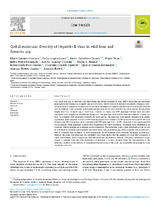Mostrar el registro sencillo del ítem
Global molecular diversity of Hepatitis E virus in wild boar and domestic pig
| dc.contributor.author | Casares-Jiménez, María | |
| dc.contributor.author | López-López, Pedro | |
| dc.contributor.author | Caballero-Gómez, Javier | |
| dc.contributor.author | Frías Casas, Mario | |
| dc.contributor.author | Pérez-Hernando, Belén | |
| dc.contributor.author | Oluremi, Adeolu Sunday | |
| dc.contributor.author | Risalde, M.A. | |
| dc.contributor.author | Ruiz-Cáceres, Inmaculada | |
| dc.contributor.author | Opaleye, Oluyinka Oladele | |
| dc.contributor.author | García-Bocanegra, Ignacio | |
| dc.contributor.author | Rivero Juárez, Antonio | |
| dc.contributor.author | Rivero Román, Antonio | |
| dc.date.accessioned | 2021-11-15T12:26:16Z | |
| dc.date.available | 2021-11-15T12:26:16Z | |
| dc.date.issued | 2021 | |
| dc.identifier.uri | http://hdl.handle.net/10396/22109 | |
| dc.description.abstract | Our study aim was to describe and characterize the global Hepatitis E virus (HEV) molecular and genotype geographical distribution in domestic pig and wild boar, which could facilitate the traceability of human cases. We performed a systematic sequence search for HEVs identified in domestic pig and wild boar from the available data in GenBank. Only sequences with lengths greater than 300 nt were included. For all sequences, the sequence length, host (i.e., domestic pig or wild boar), country of origin, and HEV genotype/subtype were recorded. Genotypes were assigned by the HEVnet typing tool. The genotype distributions were described by country and host. In countries with sequences available for both species, the genotype coincidences between both animal populations were analyzed. A total of 1404 viral sequences were included: 32.6% from wild boar and 67.4% from domestic pig. Most sequences were consistent with HEV genotype 3 (n = 1165). Genotype 4 was represented by 193 sequences, while genotypes 5 and 6 were represented by only 6 sequences. Sequences were identified in 39 countries, which included all continents except Antarctica. The genotypes with a wide distribution were 3a and 3f. Twenty-five countries had sequences that were found only in domestic pig, three countries only in wild boar, and 11 countries had sequences in both populations. In all countries with available sequences in both populations, the same viral genotype was identified. Our study shows that the number of swine HEV sequences is small, which limits direct comparisons with the sequences identified in humans. The global distribution of genotype 3, together with the wide distribution of genotype 4 in Asia, strongly limits the interpretation of the molecular analysis in the absence of an epidemiological survey of the cases. Increased HEV sequencing in swine should be a priority. | es_ES |
| dc.format.mimetype | application/pdf | es_ES |
| dc.language.iso | eng | es_ES |
| dc.publisher | Elsevier | es_ES |
| dc.rights | https://creativecommons.org/licenses/by/4.0/ | es_ES |
| dc.source | One Health 13, 100304 (2021) | es_ES |
| dc.subject | Hepatitis E virus | es_ES |
| dc.subject | Wild boar | es_ES |
| dc.subject | Pigs | es_ES |
| dc.subject | Genotype | es_ES |
| dc.subject | Prevalence | es_ES |
| dc.subject | One health | es_ES |
| dc.title | Global molecular diversity of Hepatitis E virus in wild boar and domestic pig | es_ES |
| dc.type | info:eu-repo/semantics/article | es_ES |
| dc.relation.publisherversion | https://doi.org/10.1016/j.onehlt.2021.100304 | es_ES |
| dc.relation.projectID | Gobierno de España. RD12/0017/0012 | es_ES |
| dc.relation.projectID | Instituto de Salud Carlos III. PI19/00864 | es_ES |
| dc.relation.projectID | Gobierno de España. CP18/00111 | es_ES |
| dc.relation.projectID | Gobierno de España. CD18/00091 | es_ES |
| dc.relation.projectID | Gobierno de España. FPU17/01319 | es_ES |
| dc.relation.projectID | Gobierno de España. INT20-00028 | es_ES |
| dc.rights.accessRights | info:eu-repo/semantics/openAccess | es_ES |

